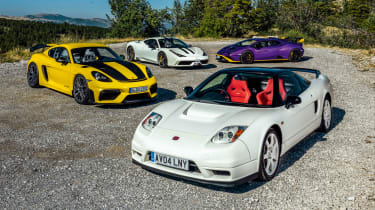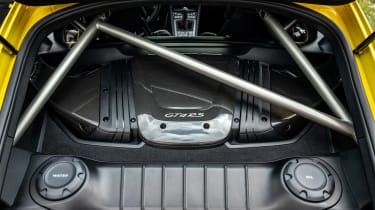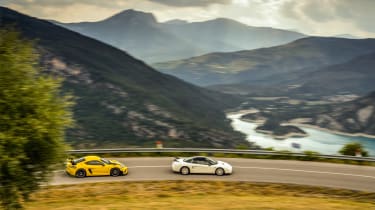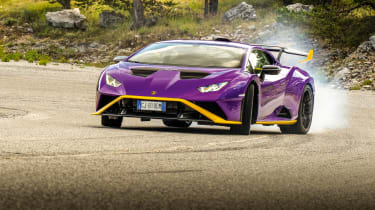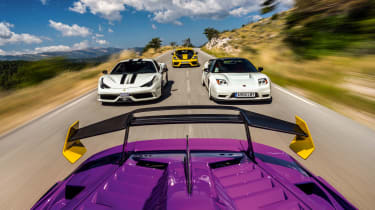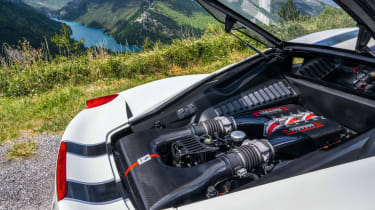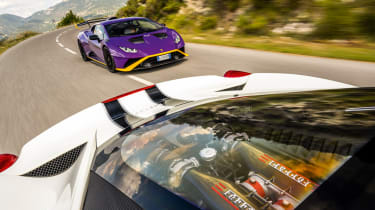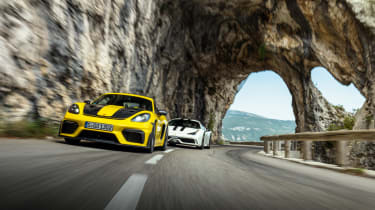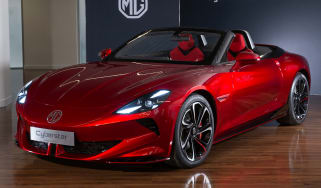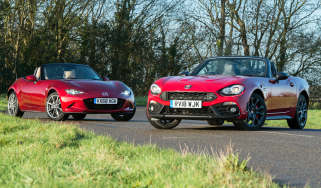Porsche Cayman GT4 RS v Huracán STO v 458 Speciale v Honda NSX‑R
The Cayman GT4 RS is Porsche's most hardcore mid‑engined car to date, so we put it head-to-head with three of the finest mid-engined machines ever to hit the road
Monza, Italy. Outside one of those anonymous business hotels that could be pretty much anywhere in the world, a time-worn single-car transporter lowers its carriage towards the ground. The sides are opened up. The delivery driver is happy despite the fierce heat and cheerily walks to each corner, dealing easily with straps and ratchets to free the cargo. Seconds later the unmistakable sound of a Lamborghini V10 is tearing through the molasses-thick air and visibly shaking the flimsy structure from which it’s emerging. Now I’m smiling, too.
Any day you get to drive a Huracán STO is a good day. But today there’s an especially heightened sense of expectation. Another delivery driver has already called to update me on his progress from Stuttgart to our meeting point in the south of France. He’s bringing a Porsche 718 Cayman GT4 RS. Speed Yellow, Weissach Pack. Oh, and a spare set of wheels and tyres. Magnesium, of course. Just a few minutes ago a new WhatsApp group, started yesterday and called ‘Mid-engined Screamers’, pinged with a picture of a Honda NSX‑R leaving Switzerland. Another owner replied: ‘See you tomorrow, guys. The Speciale is ready. Can’t wait.’
> Porsche 718 Cayman GT4 RS 2023 review – the ultimate mid-engined sports car
Well, what else were we to do? As soon as the GT4 RS was officially confirmed by Porsche, we knew we’d have to find a way to pull together some extraordinary cars. It promised so much. The basic recipe is a full-blooded 911 GT3 engine in a mid-engined Cayman chassis, but being a product of Porsche Motorsport this is so much more than a simple engine swap. This is a Cayman capable of lapping the Nürburgring in 7:09.30. And it revs to 9000rpm. It’s a Cayman that costs from £108,370 (and races to £250k on the flipper’s market).
The NSX‑R has Nürburgring provenance, too. Back in 2002 it lapped the place in 7:56.73 in the hands of Best Motoring’s Motoharu Kurosawa. Pretty incredible for a car with a 3.2-litre V6 producing a quoted 276bhp at 7300rpm and just 224lb ft at 5300rpm. Yet when you delve into the obsessive work put into creating the R it’s little wonder that Honda’s mid-engined sports car performs at such a high level. It’s almost as if the blueprint for the GT4 RS was cast over 20 years ago. In Japan.
As with the GT4 RS, the NSX’s transformation into the R was remarkably detailed and laser-focused. Each piston and connecting rod is balanced to a tolerance of half that of a standard NSX engine. The crank assembly features carefully matched components to reduce friction, the clutch/flywheel/pulley assembly is hand-machined and rotating weight tolerance is reduced to below 1/10th of that of a regular NSX. Honda claimed no more power for the R engines but much greater and more accurate response. The car joining us was dyno’d shortly before this test and made a solid 295bhp.
Similar rigour was employed on the aero, chassis and the mission to reduce mass. There’s a carbonfibre bonnet, saving 2.2kg. The hollow carbonfibre wing saves 1.3kg. Thinner rear glass shaves 200g, the instrument panel is 620g lighter and even the mesh material used for the shift gaiter saves a whole 10g. And there’s so much more. It’s a breathtaking programme and results in a kerb weight of 1270kg. A 4.1 per cent shorter final drive also helps with acceleration.
Slotting neatly between the Huracán and NSX in aesthetic terms is the Porsche GT4 RS. In scale it’s very similar to the svelte NSX‑R (it’s a smidge bigger in every dimension but with a slightly shorter wheelbase) but there’s more density to the shape and more extreme detailing, too. If the NSX‑R is a blade, sharp and honed, the GT4 RS is more like a sawn-off shotgun. The Cayman’s lovely proportions and simple shapes are lost beneath exposed carbon stripes, NACA ducts, wheelarch vents, cut-away front wings and swan-neck wing supports dangling a giant plank of carbonfibre over the rear axle. It looks angry. Intimidating, even. The GT4 RS broods in the far corner of the car park, shoulders hunched.
The fight begins tomorrow. John Barker and photographer Aston Parrott have driven the length of France in a Fer… um, Skoda Kodiaq. They look frazzled. But when I tell John that we’ll meet the 458 Speciale and its owner, Fast Fleet contributor John Black, at 8am on a road nearby, the weariness recedes. ‘This is going to be mega,’ he says. ‘I wonder if it’s as good as we remember?’ This question and many more will be answered after a deep, red wine-assisted sleep. France is bloody marvellous, isn’t it?
The old heroes can wait a little longer. I’m keen to try a new flavour and the GT4 RS is a mouth-watering prospect. Even reversing it out of the narrow hotel car park leaves an indelible impression. The flat-six buzzes and drones through the interior; it revs so fast and the gearbox seems so aggressive that manoeuvring is tricky and the GT4 RS emerges into the little village in a series of lurches despite the PDK ’box. Bloody hell. They’re not messing around.
Trickling along at first, the RS shuffles and thumps on frigid Cup 2s. The suspension is stone-cold and unyielding and the whole car feels like it’s got out of the wrong side of bed. I like it. For me this awkward, jarring phase is all part of a truly hardcore road-racer. It should feel grumpy as vital fluids warm through, and sensing all the rough edges being chipped away as the temperature gauges start to flicker to life is the best sort of initiation.
Our meeting point is a short, 25-minute hop from here and the route straightens for no more than a mile over its duration. It dissects, joins and later veers off the Route Napoléon as it weaves its way across the Préalpes d’Azur and the Porsche quickly finds its comfort zone. It remains a physical and intense experience but now the suspension is parrying bumps, the tyres are locked into the surface and that 493bhp 4-litre is ready to be wrung out. It’s a step beyond the GT4, that’s for sure.
The NSX‑R has tracked the GT4 RS like a ghost in the mirrors. John has been getting reacquainted with the car’s peculiarities and its charms. ‘It feels 20 years old in some respects,’ he begins. ‘It has a fairly ordinary sounding engine when it starts up. But, there’s that tight, snickety gearbox and fabulous seats. And there’s a dichotomy going on here. The steering is heavy and the car almost feels slightly lazy at first. But you’re going like the clappers. It really can keep up, and it’s so easy to get into a flow. Such a cohesive, wonderfully realised car.’ After the jarring sounds pulling me out of the GT4 RS experience at times, that cohesiveness sounds deeply appealing. I want to jump straight into our generous Swiss collector’s stunning NSX‑R, but the high-pitched scream of a Speciale flying up the hill to meet us diverts my attention.
Moments later John Black is greeting us as the Speciale furiously ticks and clinks from its workout. It’s white – I like to imagine in deference to the NSX‑R – and once again the pumped-up GT4 RS and vivid purple Lamborghini look like they’re trying a little too hard. The Speciale is gorgeous and purposeful without having ‘race car’ tattooed on its forehead. Almost subtle. I vow to wait a while before trying it. And to savour every second. The cover shot is in the bag moments later (okay, probably more like hours, eh Aston?) and we’re heading west again, retracing our steps for a while and then being treated to a long, unbroken run of Route Napoléon.
The STO eats it up. After the intuitive GT4 RS there’s more to adapt to here. The steering is too light in STO mode, so you must ramp everything up to Trofeo. Even with the added weight, the front end is so positive it takes a while to slow your hands. The brakes are inconsistent. Sometimes they grab the Huracán hard enough to stand it on its nose even when you just want a confidence dab, then the next corner the pedal might be longer than anticipated. It’s annoying but you learn to live with it, for so much of what the STO does is of the highest quality.
It’s dominated by the engine and gearbox, which are nothing short of staggering. As John later says: ‘For me this is better than even the LFA engine.’ Some praise. Honestly, the STO makes the Porsche feel breathless and although you could argue there’s too much noise (you can hear it for literally miles), there’s no denying the quality of the shattering howl and how real and organic it feels.
Incredibly, the chassis doesn’t just play a supporting role here. There’s so much front-end grip and such reassuring balance that it’s almost prodding you to explore the V10 in ways you never have before. The STO loves to carry speed, streaming into corners fast and perfectly in control. You don’t feel the rear-steering’s work but boy do you appreciate the agility. Then you can really get into the power, leaning on the front-outside wheel and carving clean lines.
Understeer? The STO doesn’t do that on the road. Ever. It just feels nailed to the apex, and as the V10 climbs the rev range from mid-corner onwards, simply unwind the steering lock as the rear takes on the slightest yaw angle. Firing onto straights in this deliciously poised state, giving the engine its head and hitting an upshift just as the V10 brushes the limiter is mesmerising. The melding of total control with such raw, untamed performance is about as exciting as it gets. The STO can feel too stiff and intolerant of timid mid-corner lifts at times, plus the weight of the V10 starts to tell at really high speeds, but for the most part it’s just an overwhelming experience. Emerging at the next stop, I can barely believe this much fury is legal. It’s indecent.
‘I can see why you were umming and aahing a bit about the GT4 RS,’ says John, snapping me out of my STO-induced daze. ‘The noise… It’s like you’re listening to feedback from a microphone right in the engine compartment. You’re privy to all of its little squeaks, rumbles and rattles. It’s just not what you want to hear.’
Yet when you get beneath the soundtrack there is quality. Lots of it. ‘The performance is phenomenal. The top end is exciting and, most of all, the GT4 RS has great flow. So precise and satisfying.’ John sounds impressed, but also like a man who’s found something more bewitching: ‘The NSX‑R does suggest there are areas and opportunities that haven’t been exploited, though. Straight after the Honda there’s a real pause, a real moment of take-up when you make a steering input. Yes, the RS is a little sharper than the GT4, but considering how it looks… it doesn’t quite match your expectations.’ The RS is brilliant in some respects but isn’t quite giving John the goosebumps, either. I think we’re both in agreement that whilst the engine is boiling over with raw feedback, the chassis could do with a little more.
The NSX‑R’s carbon-Kevlar seats are almost sumptuous. So supportive but with a soft touch. Why can’t all fixed-back seats feel this good? You sit in a reclined position, perhaps because the seat is mounted a shade too high. Then again, maybe that’s an illusion created by the plunging windscreen that seems to end almost at road height and the frankly wonderful view it affords. The small, three-spoke steering wheel is another impeccably judged touch-point and you can’t help but grip it with a smile, then practise a few shifts (so short, so precise and that lovely titanium shifter feels machined from the same billet as the slack-free ’box). John’s right, the engine starts without a hint of drama but any sense of disappointment in that millisecond as you turn the key is the very last time the NSX‑R isn’t completely captivating. Things are about to get very good indeed.
No period to adapt or learn techniques is required. The NSX‑R immediately feels right, in every detail. The steering is sublime. There are those who will tell you that good EPAS is really, really good. Ignore these people. They are fools, liars or simply haven’t driven a car with real steering feel. Ten seconds in the NSX‑R is enough to make the Lamborghini appear hopelessly vague; a minute later you’re wondering what the GT4 RS might feel like if they ditched power assistance altogether. The NSX‑R’s manual rack requires more force and is slower by necessity than the ultra-pointy newer cars but it’s loaded with detail. Such clarity is rare and incredibly empowering. The NSX‑R might be scarce and valuable but there’s no hope of driving it like a museum piece. It gives you too much encouragement and serves up the road without corruption. ‘Here it is,’ it seems to say, ‘now enjoy it.’
The ride is still pretty firm even in a world of STOs and GT‑Rs, but with such palpable balance and without the burden of huge weight and massive power there’s connection but never harshness. Just like the GT4 RS, this is a car that flows. It’s transparent, too. Push too hard on entry and it’ll gently understeer. You’ll know it’s coming, of course. That steering imparts everything. Go harder still or brake right into the apex and the rear loosens and starts to edge around.
Try this in the GT4 RS and it’s quick to back itself into the corner. The NSX‑R’s behaviour is more subtle. Adjustable but never requiring fast reactions. All the agility and speed is delivered by the car with serene composure. Even when you’re punching in shifts, braking late and hard and pouring energy into the car. The NSX‑R uses your effort, repays the work, but it does so with ever greater accuracy and resolve, not frantic response. There’s an old saying about not trying to drive faster but instead to drive better. The NSX‑R works to the same values. It never appears rushed or on the edge of its capabilities, even when you’re at maximum attack and clinging on to the back of a 631bhp supercar.
I’m searching for superlatives when the radio crackles to life. Usually this would be Aston asking for a car to be moved 3mm to the left, 6mm back and maybe a bit of right-hand down. But no. It’s John from the driver’s seat of the 458 Speciale. ‘F**kin’ ’ell.’ That’s it. That’s all he’s giving us. I think he likes it.
You remember the 458 Speciale? The last naturally aspirated V8-powered Ferrari, it’s a 458 Italia with 90kg slashed away via stripping the interior, lighter glass and a Lexan engine cover; a 458 fitted with a tweaked 4.5-litre V8 producing an astonishing 597bhp at 9000rpm and with gearshift times cut by 44 per cent; the Ferrari that introduced Side Slip Control; the only car ever to win eCoty unanimously. And, it seems, a car that John still thinks is okay. As I climb in, he sidles over. ‘Oh. My God. No, really. OMG.’ I’m sure he’ll recover his faculties soon.
Things don’t get off to an especially good start. The Speciale interior is pleasingly simple. The inner doors are carbonfibre, the floors bare. Just as you’d hope. However, it feels oddly big and empty. Like there’s a lot of dead space. The Porsche, Honda and Lambo envelope you but the Speciale doesn’t seem to want to embrace. Grab the steering wheel and it feels huge, almost cumbersome, and although the seats are supportive they’re also extremely upright. The harnesses (admittedly an option) are a bit of a faff, too. The Porsche and Honda in particular nail the driving environment. This feels somehow self-conscious and a bit of a mess.
Twist the key, depress the proud red starter and the V8 catches quickly and the cabin resonates like an empty tin can. It’s a flat, monotone noise owing to the flat-plane crank and has none of the Lamborghini’s musicality at low revs. This is not quite the car I remember. Luckily, the wheels haven’t started turning yet. Perhaps my OMG moment is just around the first corner.
It doesn’t take that long. In many ways the Speciale is diametrically opposed to the Honda. Where the NSX‑R has heavy steering and a slowish rack, the Ferrari’s is light and extremely alert. The mechanical connection of the six-speed manual is replaced by scintillating speed with that seven-speed dual-clutch ’box. Even in terms of balance they come at things so differently. The NSX‑R is set up to gently understeer first and then start to dance. The Speciale never even threatens to miss an apex and doesn’t need any encouragement to get up on its toes. Its agility is ever-present and any slip you find will only be at the rear. But for all these differences they are united by the most important common quality. Each provides the driver with total confidence.
This appreciation comes later. Firstly, the Speciale is overwhelming. It steers so beautifully. The rack is quick, like on all modern Ferraris, but there’s more weight than with a standard 458 Italia and more feedback, too. You need that weight in particular, as the Speciale is so reactive that you want something to lean against. The V8 is stunning. There’s such crackling, frenzied power and although it can’t match the stupendous high-rev energy of the STO, having such power in a car that feels so light and so poised opens up new thrills. The Speciale doesn’t seem to hold any inertia. It just does.
Yet the true magic, the reason you can exploit this 597bhp mid-engined Ferrari with the freedom and confidence as if it was a Clio Cup, comes from the damping. The way it connects you to the surface yet holds the body with such ease borders on the surreal.
> Ferrari 458: review, specs and buying guide
The Speciale weighs well over 1400kg with me on board and yet you’d swear it was no more than a ton. There’s frantic performance, wrist-flick agility, huge cornering power and minutely adjustable balance – all helped by the superb SSC system that allows you to push deep into its ultimate capabilities – but the car remains so calm, so eerily on top of everything that’s rushing under its tyres.
‘The whole thing snaps into focus immediately, doesn’t it?’ says John. He’s had enough distance from his last drive to make some sense of the Ferrari. So I just nod and listen. ‘The engine is manic, the response is insane. Initially, it’s properly shocking,’ he continues. ‘But then you realise that you’re not on edge. The car isn’t too much. It’s frantic in sound and performance but calm in the way it drives. The damping is extraordinarily good – filtering out all the bad stuff but leaving you connected. And the steering is so precise. That’s where all the confidence comes from. Peak Ferrari. And such is its ability that you end up re-evaluating the other cars here.’
If anything, the Lamborghini’s defining feature grows in stature in the context of the Ferrari but ultimately hampers its ability, too. The 5.2-litre V10 puts the Speciale motor in the shade in terms of outright top-end power and character – and remember that the 4.5-litre V8 is one of the all-time greats. But whereas the STO feels like its engine would spin to 10,000rpm and continue to deliver ever more power if the limiter didn’t call time, the Speciale’s starts to fade away. This might seem laughable if you drive a Speciale in isolation but, incredibly, the STO has greater reach. It’s the very definition of outrageous.
Yet you can feel its mass hurting the STO at times. ‘After the Ferrari, you realise that the front and rear of the STO feel like different entities,’ John says. ‘It’s not a problem. This is a fabulous, thrilling car. But once you’ve tasted the Ferrari’s lack of inertia and that locked-together feeling, everything else starts to come up short.’ Add to that a slightly less detailed picture through the steering, and the inconsistency we experienced in the brake feel and response, and the Lambo – much as we love it – can’t quite overcome the Speciale. There’s no shame in that.
‘The NSX‑R is closest to the Speciale. It has the same philosophy,’ John continues. ‘There’s a lack of inertia that maximises the performance of the engine. Driven at nine-tenths it’s a little bit of a workout but the pace is there, and it’s a joy to row it along. And what a gearbox! Such a sweet car.’ It really is something special. For me the detailed steering, the stripped-back feel of the entire car and how that brings such a sense of purpose, plus the remarkable precision of the engine and gearbox, combine to stunning effect. That it still hangs with the newer cars on give-and-take roads only adds to the appeal. But never mind the quantity of performance, feel the quality. It remains one of the most engaging, immersive and exciting cars I’ve ever driven.
The Porsche carries so much of what’s precious about these cars. The intensity of the performance, the rev-hungry and exotic feel of the engine, the sheer bite of the chassis which, remarkably, isn’t at the expense of fluidity. The GT4 RS really does tick so many boxes. I love the sharpness on the way into turns and the way it can be thrown in hard on the brakes and immediately snap into controllable oversteer. It has attitude and ability in abundance. We’ve waited a long time for a Cayman like this and in so many ways it’s been worth it.
Yet, in truth, it never quite has us bubbling with wonder in the way we do about the Honda and Ferrari. Nor does it have the sheer laugh-out-loud intensity of the Lamborghini. Perhaps on track this would all swing wildly in the other direction. In fact, I’m almost sure it would. But on some of the best roads we know, in perfect weather and over two glorious days, the GT4 RS doesn’t quite get under our skin.
The noise is more than an annoyance: its relentlessness eats away at your enjoyment. There are other areas to nitpick, too. The PDK ’box is fantastic but, in the company of the Lamborghini and Ferrari systems, it lacks a sense of connection. It’s more digital. It’s telling that in the two Italian cars you never, ever want for a manual, but in the GT4 RS you crave it within ten minutes. It needs that extra layer of involvement. We leave deeply impressed but without those perfect memories served up so readily by one car in particular.
‘It’s head and shoulders above the rest,’ enthuses John. That’s quite some statement in this company, but I think he’s probably right. The Ferrari 458 Speciale is sublime, magnificent, outrageous, unbelievable. To deliver this level of demonic performance and sharpness with such control and grace is remarkable. ‘Totally rounded in its abilities,’ explains John. ‘Everything fits together beautifully. The steering, the ride, the handling, the performance, the gearshift… it is a masterpiece of a car.’ That word – masterpiece – nails it completely. The Speciale feels like a moment in time, a project for the ages and a tribute to all the naturally aspirated V8s that have gone before. The Speciale is the very myth and legend of Ferrari incarnate in metal and carbonfibre. We came here to discover if the Porsche Cayman GT4 RS was one of the true greats. By the time we come to leave, there’s another question hanging in the air. Will it ever get better than the Ferrari 458 Speciale?
Thanks to Eurotunnel for getting us across the Channel. Book your Flexiplus crossing at eurotunnel.com
This story was first featured in evo issue 301.

